
views
Logistics
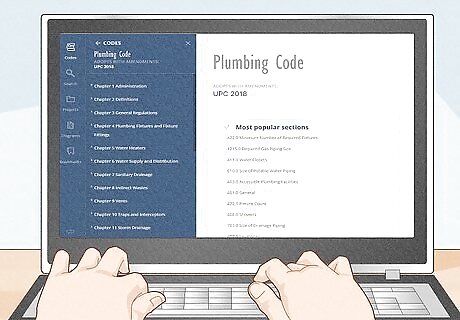
Pull the plumbing codes before you take the first step. The location of each fixture and pipe, the materials you’re allowed to use, and the requirements for performing this kind of work all differ from state to state (and city to city). Go online and review the plumbing code where you live to see what you’ll need in order to do this legally and correctly. Sewage is toxic and can create noxious fumes. As such, many cities/states hold plumbing codes to a standard similar to that of gas lines. You may not be allowed to plumb the bathroom on your own without the help of a licensed contractor.

Submit plumbing plans and file for permits with your city. Either compose the diagrams for the plumbing plan yourself, or hire a plumber to create plans for you. These plans must be up to code depending on where you live. If live somewhere that requires permission from the city or state, submit the plans and apply for permits. You may need to have a building inspector come out to review the space before you’re approved to begin work. If you’re doing the drawing yourself, the diagrams must be set to scale on grid paper. You must include the location of each fixture and pipe, the material you’ll use, the locations for valves, and a depiction of how the bathroom will be vented.
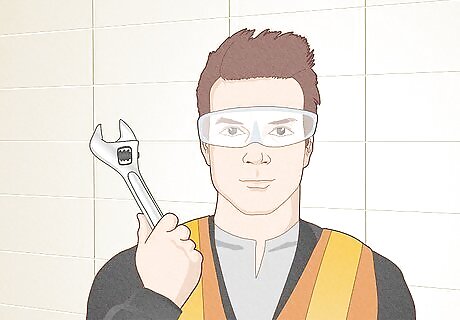
Hire a professional to run your lines if possible. This is not straightforward DIY work, and the risks here outweigh the rewards most of the time. If you can afford to hire a plumber or contractor to plumb the bathroom, do it. While you can definitely install your own toilet, vanity, and tub, running water lines and soldering pipes are going to be tall orders for a non-professional. If water lines aren’t installed correctly, you could end up with a leak. This is especially disastrous if we’re talking about sewage or grey water, which could be extremely expensive to repair.
Water Lines
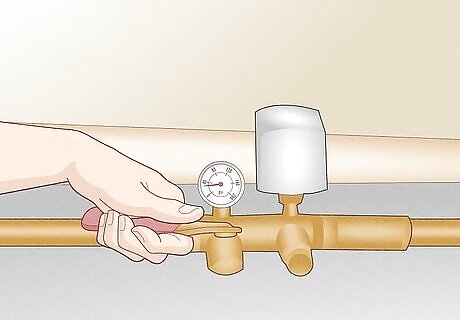
Shut the water off for the entire building at the main valve. Before doing any work on your plumbing, you will need to turn off the bathroom water lines so that you don’t risk leaks or flooding. Locate the valve where the water main connects to your building and turn it off. The main valve will be near your water meter. Some houses have the meter outside, while in other houses the meter will be inside. If you have a basement, there’s a good chance that is where your water meter is. Check outside near the back foundational wall to see if it’s there. Call the water company and ask for assistance if you’re having trouble locating your valve.
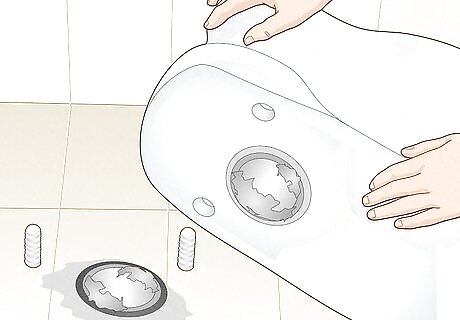
Remove any existing fixtures you don’t want. If you’re replacing your toilet, start by draining the existing one. This will help prevent any unpleasant leaks or spills. Remove the toilet, sink, and tub and clear out any debris created by taking these fixtures out. You will probably need help with this part. Bathroom fixtures, especially bathtubs, are really heavy. Ask a friend to help you so that you can avoid straining too much and hurting yourself.
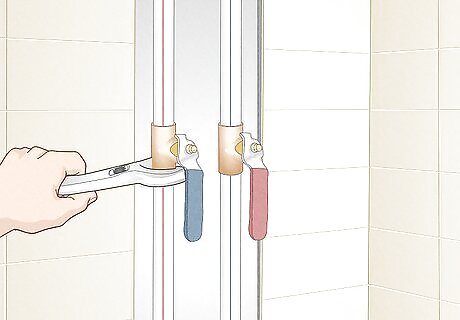
Install the hot and cold water lines for all of your fixtures. This is one of the most important parts since all of your bathroom fixtures need a water source. Most bathrooms require 5 water lines: a hot and cold line for both the bathtub/shower and the sink, and a cold water line for the toilet. Each fixture and house are different, so hire a pipefitter or plumber to run the lines for you if possible. The most popular material for water lines these days is PEX (short for cross-linked polyethylene). PEX is flexible, and much easier to work with than copper, steel, or PVC. If you’re doing this yourself, you’ll need a PEX pipe cutter, crimp rings, elbow fittings, push-to-connect fittings, a crimping tool, deburring tool, go/no-go gauge, marker, and tape measurer. You can either run these lines through the wall or up from the floor, depending on the location of your bathroom.
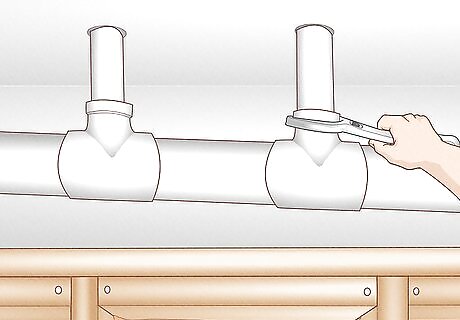
Connect the drain lines to the corresponding pipes. For your bathroom, you will need multiple sizes of drain lines. This is where used water will drain to the sewage line or septic tank. Each drainage line must be sloped per your city and state plumbing code so that dirty water flows naturally downward. Follow the instructions for the fixtures that you are installing. If you run into any difficulties, contact a plumber. Your drain lines must have vents to allow air into the drainage lines. The free air flow will help keep dirty water flowing smoothly downward.

Determine the rough-ins for your toilet, sink, and tub. A rough-in refers to the distance from the pipe or line in a wall to the final point of connection for an appliance. For the toilet, it’s the sewage drain. For the tub, it’s the water drain. You’ll also need the measurement for the sink drain. These measurements are essential for purchasing fixtures that will actually fit in your bathroom. Toilet rough-ins are typically either 10 inches (25 cm) or 14 inches (36 cm). There are no standard rough-ins for tubs, but they’re typically 6–18 inches (15–46 cm). Sink rough-ins vary as well, but since PVC pipe configurations are forgiving, it’s not as key. The main thing to look out for is the height. Your vanity’s drain must be taller than the drainage line, or the water won’t flow downward.
Toilet

Install the soil pipe and closet flange on the ground. Stuff an old rag into the soil pipe to prevent sewer gas from escaping. Use PVC primer to connect the soil pipe and flange. Seal with PVC cement. Quickly insert the soil pipe into the bend before the cement dries. Wiggle the flange into place on the soil pipe until the collar of the flange is flush with the floor.
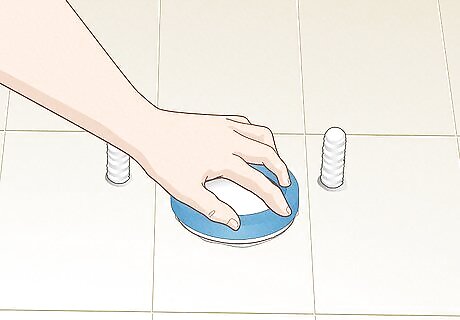
Set a new toilet seal in place to prevent leaks. Remove the toilet seal from the packaging. The easiest way to do this is to simply place the seal in position on the flange before you lower the new toilet into place. If you prefer, you can place the new toilet on its side on the floor and press the new seal directly onto the toilet base. This is more difficult, but it does ensure that the seal is precisely placed on the toilet.

Put the toilet over the seal secure it in place with bolts. Toilets usually come in 2 pieces: a tank and a bowl. Start by installing the bowl. Connect the closet flange from the waste pipe to your toilet. Set the bowl over the bolts and on the flange. Once it’s level, tighten the bolts to secure it in place. You may want to sit on the toilet and rock back and forth a bit to get it on correctly. Attach the toilet's tank to the bowl using nuts.
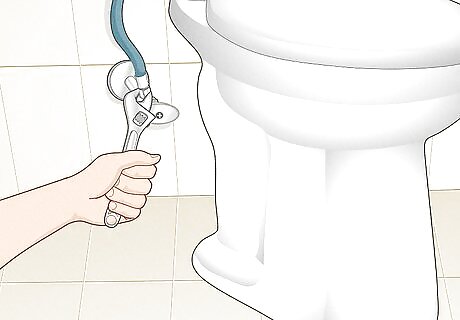
Connect the water line to the toilet using the supply lines. This part is much easier than it sounds. The water line will have a valve sticking out of the wall that will connect to the toilet. Attach the supply line that came with the toilet to the valve in the wall and the valve on the tank of the toilet. Remember, there’s only one line for the toilet since it only uses cold water. You do not need to buy two supply lines. You can run caulk around the toilet if you want to keep the seal secure. This may make it harder to identify leaks in the future, though.
Sink

Use the mounting hardware that came with your sink. Putting in a new sink isn’t terribly difficult, but how you do it definitely depends on whether you are installing a sink in a vanity or a standing sink, like a pedestal. Your new sink will come with mounting hardware that is specific to the type of sink you chose. Install the mounting hardware according to the manufacturer’s instructions.
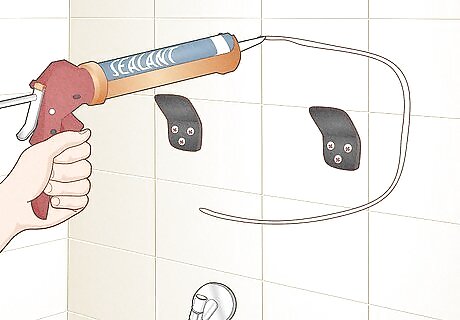
Use a caulk gun to seal the area where the sink meets the wall. This is a really important step, as you definitely don’t want a leaky sink. Use your caulk gun to place caulk at the site where your sink will connect to the wall, stand, or vanity. Use a little more caulk than you think is necessary to ensure a tight seal.

Install the sink by setting it in place and secure it with bolts. Start by positioning the stand to do a test fit. Mark where the floor bolt should go and drill a hole through the sink stand and fasten it to the floor using a nut and bolt. Connect the sink to the hot and cold water lines. Also connect the handles, stopper, and drain to the top portion of the sink. Set the sink onto the stand and glue an adapter with threads to the drain pipe.
Bathtub and Shower

Orient the bathtub over its drain and check that it is level. Unpack the new tub from the packaging and set it into the space you have prepared. You’ll need help here, since tubs are heavy. Once you set the tub, use a level to make sure that the tub isn’t tilting in any direction. If there were one fixture you could hire a pro to install, the shower and tub would be it. This one is tricky because you often have to remove drywall to troubleshoot if everything doesn’t fit perfectly. Check where the tub meets the existing floor. If the tub apron overlaps onto the floor, neatly trim the flooring back so that the tub fits. Once the tub is firmly in place, anchor it to the wall studs as recommended by the manufacturer.

Set the back portion of the surround in place then add side panels. Position the back so that it is straight and level and do the same with the sides. Chisel off any protruding studs and level off any drywall that is not even. This will help ensure that the surround is straight. If the panels don’t align with the edge of the tub, check your tub again to make sure that it is level. Adjust if necessary.
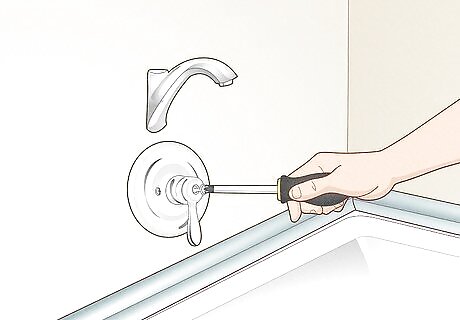
Screw in the new fixtures and finish by caulking the seams. Once you have them in the position you want, mark the spot on the panel where they will sit. Use your tool to carefully cut out a piece of panel big enough for your faucet and spout to fit. Then, install the valves, faucet and spout in accordance with the manufacturer’s instructions. The size will depend on how large your fixtures are. Measure them before you cut to make sure you’re making a big enough hole in the panel. Running a thin bead of caulk around the fixtures in your bathroom will help to keep water from getting in.


















Comments
0 comment